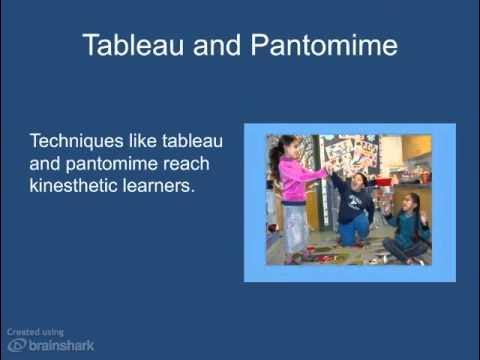Perencanaan Pementasan Seni Teater Tradisional untuk Kelas X Semester 2
Summary
TLDRIn this educational video, the instructor, Fitriana Nur Rahma, teaches students about the planning and execution of traditional theater performances. The lesson covers key aspects such as the definition of traditional theater, the steps in designing a performance, and the roles involved in the process. It emphasizes the importance of preparation, from planning and organizing committees to selecting scripts, preparing materials, and ensuring proper publicity. The video also explores techniques and strategies for successful theater production, highlighting the collaboration and effort required to deliver a compelling theatrical performance.
Takeaways
- 😀 The lesson is focused on designing traditional theater performances.
- 😀 The main learning objectives include understanding the definition of traditional theater, the process of designing a performance, and the techniques involved in staging it.
- 😀 Students will learn to describe the concept of designing a traditional theater performance accurately in writing.
- 😀 Key components of designing a theater performance include understanding the roles of performers, the production team, and the audience.
- 😀 Traditional theater is defined as a performance involving local actors and stories rooted in regional myths or legends, and is often part of religious or cultural rituals.
- 😀 Designing a theater performance involves planning, executing, and evaluating, with a focus on conceptualizing techniques and procedures for a successful show.
- 😀 The elements of a theater performance include performers, creators, materials, audience, and publicity efforts.
- 😀 In traditional theater, the focus is on cultural and social practices that reflect the community's values and traditions.
- 😀 The stages of planning a theater performance include selecting the script, forming a production team, assigning tasks, scheduling rehearsals, and preparing a proposal for the performance.
- 😀 The preparation for a theater performance involves ensuring all aspects are ready, from creating props and makeup to setting up the stage, organizing publicity, and arranging for the audience.
Q & A
What is the main focus of this lesson?
-The main focus of the lesson is the planning and execution of traditional theater performances, specifically how to design a traditional theater performance by understanding its concepts, techniques, and procedures.
What are the learning objectives of this lesson?
-The learning objectives are for students to explain the concept of designing a traditional theater performance, describe the activities involved in this process, and identify the techniques used in the planning of a traditional theater performance with an 80% accuracy rate.
What is the definition of traditional theater as explained in the script?
-Traditional theater, also known as regional theater, is a form of performance where the actors come from the local area and perform stories that have deep cultural roots, often based on myths, legends, or rituals that are part of the community’s heritage.
How does traditional theater reflect the local community?
-Traditional theater is closely tied to the customs, beliefs, and geography of the region it comes from, often reflecting the community's social structure and cultural environment. It also follows local traditions and practices, making it an integral part of cultural expression.
What does the term 'designing a theater performance' mean?
-Designing a theater performance refers to a series of activities, including planning, execution, and evaluation, aimed at achieving the performance's goals. It involves understanding the concepts, techniques, and procedures necessary for a successful theater production.
What are the key components involved in designing a theater performance?
-The key components include the performers (actors, dancers, musicians), supporters (non-artistic roles), materials used in the performance, the audience, and publicity efforts to inform the public about the performance.
What are the steps involved in the planning phase of theater production?
-The steps include meetings with the school and committee, forming the core production team, selecting the script, organizing the crew, assigning tasks and responsibilities, scheduling the production, and preparing the theater performance proposal.
What is the purpose of the 'execution phase' in designing a theater performance?
-The execution phase involves the production team taking action to ensure the success of the performance. It focuses on effectively utilizing available resources, managing opportunities, and evaluating progress to meet the performance's goals.
What are some of the essential elements of preparing the theater production?
-Key elements of preparation include preparing the performance material, the stage and props, makeup and costumes, the venue, partnerships (e.g., sponsors), publicity (e.g., posters), and organizing the audience's seating and comfort.
Why is the audience considered a crucial part of a theater performance?
-The audience is considered crucial because they are the recipients of the performance, and their experience and engagement are essential for the success of the theater. Proper attention is given to providing a comfortable and suitable environment for them.
Outlines

Этот раздел доступен только подписчикам платных тарифов. Пожалуйста, перейдите на платный тариф для доступа.
Перейти на платный тарифMindmap

Этот раздел доступен только подписчикам платных тарифов. Пожалуйста, перейдите на платный тариф для доступа.
Перейти на платный тарифKeywords

Этот раздел доступен только подписчикам платных тарифов. Пожалуйста, перейдите на платный тариф для доступа.
Перейти на платный тарифHighlights

Этот раздел доступен только подписчикам платных тарифов. Пожалуйста, перейдите на платный тариф для доступа.
Перейти на платный тарифTranscripts

Этот раздел доступен только подписчикам платных тарифов. Пожалуйста, перейдите на платный тариф для доступа.
Перейти на платный тарифПосмотреть больше похожих видео

Video Pembelajaran Seni Budaya - Konsep Kepanitiaan dalam Perencanaan Pementasan Teater Tradisional

Karawitan Campuran||Materi Kesenian Daerah KL 9 Smt 1||#karawitan #gamelan #keseniandaerah

RANCANGAN PENELITIAN SOSIAL - Materi Sosiologi Kelas 10 SMA

Informatika | Sistem Operasi | Algoritma Round Robin (RR) | Penjadwalan Proses | Kelas X

JENIS, FUNGSI, DAN UNSUR SENI BUDAYA NUSANTARA/SENI TEATER/ MATERI SENI BUDAYA KELAS X SMK

Informal Theatre and Creative Drama
5.0 / 5 (0 votes)
